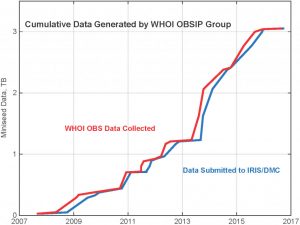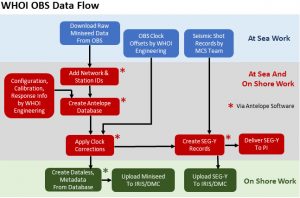Supporting Discovery
Interactive map showing OBH/OBS deployments (>1,700) by the WHOI OBS lab since its founding in 1975. OBSIP deployments (919) are shown by the colored spheres. Pre-OBSIP deployments (785) are shown by the colored squares.
| Pre-OBSIP |
|---|
| OBSIP |
|---|
Data Quality and Delivery

Cumulative data acquired by WHOI OBS Lab under OBSIP and the history of SEED data delivery to the IRIS DMC. (click to enlarge)
Since the formation of OBSIP in 1999, the WHOI OBS group has carried out 919 OBS deployments and recoveries for a total on-bottom time of more than 330 years. Every byte of data, whether from an active-source or broadband experiment, has been archived at the IRIS Data Management Center in SEED format. Active-source data have been archived at the IRIS Data Management Center in SEGY format. Loss rates for WHOI OBS, since OBSIP started in 1999 are 2% for both short-period and broad-band OBS.
Data Flow
We use the Antelope software package from BRTT to make a fully valid database prior to shipping miniseed files and a “dataless” file to the IRIS Data Management Center. We also store Antelope databases for all our experiments on a multi-terabyte mass storage system for QA/QC.
Computers and Networking
The WHOI OBS Lab includes an extensive network and IT infrastructure. A private Local Area Network (blue) with over one hundred connections enables continuous monitoring, testing, and troubleshooting of all instruments. Interconnections to WHOI's Wide Area Network (green) and the internet provide secure access and remote, off-site backup of all systems. A lab file server contains all engineering documents and records, instrument and major component histories, and field records, logs, and notes from every experiment and is mirrored inside sea-going lab vans for complete and immediate availability in the field. The Experiment Data Repository holds all of the raw, original OBS data as well as the processed miniseed data accessible via an Antelope database for each experiment.
